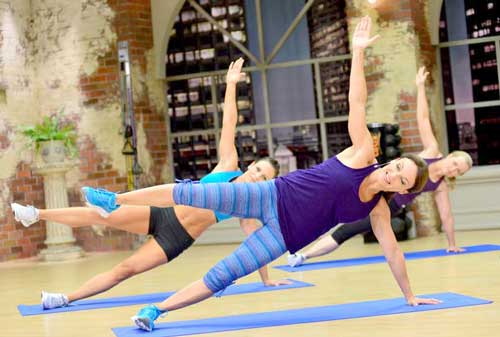
If there’s one group of muscles you don’t want to ignore, it’s the muscles that make up your core. You often hear core muscles referred to as the “powerhouse.” That’s no exaggeration. You need strong core muscles to generate power, provide stability and enhance your performance in sports and weight training.
Most people think of their core as being their abdominal muscles, but core muscles also include muscles that support your spine, your hip abductors/adductors, hip flexors, and the muscles that make up your trunk and your pelvis. In fact, a total of 29 different muscles make up your core. Abdominal exercises alone aren’t enough to strengthen your core because you’re only working some of your core muscles. This is not a very balanced approach to core training.
Why You Should Work Your Core
Why do you need a strong core anyway? Core strength is important if you participate in any kind of sport or fitness activities for better performance and to reduce your risk for injury. A weak core limits the amount of power you can generate in your lower extremities even if your legs are strong. Plus, if your core muscles aren’t sufficiently strong, your posture will suffer and you’ll be more susceptible to back pain and injury.
Strengthening Your Core: Are Isolation or Integrative Exercises Best?
One popular approach to core strengthening is isolation exercises. Isolation exercises work a single muscle group. Examples of isolation exercises that target the core and abdomen include abdominal crunches, back extension, and oblique crunches. These exercises primarily activate your abdominal muscles (for crunches) and lumbar muscles (for back extension exercises.) In contrast, integrative core exercises activate other muscles including those in the shoulders, hips, and extremities. Examples of integrative core exercises are side planks with an arm raise and a hover plank with contralateral arm reach.
Does one approach offer benefits over the other? In a study published in the Journal and Strength Conditioning Research, researchers asked 10 men and 10 women to test this idea. The participants were asked to perform a total of 7 core exercises, 4 of which were isolation exercises and 3 compound core movements. Isolation exercises included bird dog with resistance, back extensions with arm elevations, oblique crunches, and standard crunches. The compound exercises including side planks with arms raises, mountain climbers with hip flexion towards the opposite elbow and hover with contralateral arm reach. As they did each exercise, electromyography was used to measure the degree of muscle activation.
Based on this study, compound core exercises offer the biggest bang for your core training buck. When the study participants did core exercises that targeted not just abs and back but other muscles like the shoulders and glutes, they experienced greater activation of their abs and lumbar muscles based on electromyography. For example, hover with contralateral arm reach activated the rectus abdominis muscles 27% more than abdominal crunches. That’s a significant difference.
If you focus too much on abdominal crunches and back extensions, you won’t give your core muscles the type of workout they need for greater strength, endurance, and stability. A better approach is to add more core exercises that incorporate your shoulders, hips, and trunk into the movements. Using this integrated approach is better for building functional strength too.
Keep in mind your core muscles work together to stabilize, bend your body backward, help you twist, move to the side and stretch backward. Dynamic core exercises that bring the muscles in your proximal and distal trunk into the movements are ideal for building core strength and increasing core stability and mobility. Plus, these movements add an additional balance challenge you don’t get when you do core isolation exercises like abdominal crunches.
A Balanced Approach to Core Training
Does this mean you shouldn’t do isolation exercises like abdominal crunches? Definitely not. An ideal core training program should incorporate both types of core movements – isolation and integrative. If you have limited time, stick with integrative exercises.
Unfortunately, some people get into a “rut” with core and abdominal training and focus too much on isolation core exercises, especially abdominal crunches. This study showed activation of the rectus abdominis is greater with a hover with contralateral arm reach than with a focused abdominal exercise like crunches. So, you’re getting more six-pack action with the integrative exercise. Plus, you get the benefit of activating other core muscles as well as an added balance challenge.
The Bottom Line?
Make sure you’re doing some form of core training at least twice a week. When you do a core workout,a portion of the exercises you’re doing should be complex movements that bring your proximal and distal trunk muscles into the movements. Doing so activates more total core muscles and activates them to a greater degree than isolation exercises. Integrative core exercises also “teach” these muscles to work better together in a functional manner. You also activate your core muscles to some degree when you do compound weight-training exercises like squats, deadlifts and military press. Focus on keeping your spine in a neutral position and your core muscles contracted during the movements to help strengthen your core and improve your posture.
Core training offers many benefits. Don’t neglect your core muscles. When you do work them, strike a balance between integrative and isolation core exercises and don’t focus too much on crunches.
References:
Journal of Strength and Conditioning Research. 27(3) 590-596.
Penn State. “OPTIMAL CORE TRAINING FOR FUNCTIONAL GAINS AND PEAK PERFORMANCE: CXWORX”
ACSM’s Guidelines for Exercise Testing and Prescription, Lippincott Williams and Wilkins. (2005)
Related Articles By Cathe:
How Strong Are Your Core Muscles?
Core Stiffness: What It Is and Why It’s Important
Should You Train Your Obliques?
Signs You Have Weak Core Muscles and How to Power Up Your Core
Is There a Best Time to Train Your Abs?
Abdominal Exercises: Are You Doing Too Many Reps?
5 Ways to Get More Benefits from Abdominal Training
Related Cathe Friedrich Workout DVDs:

